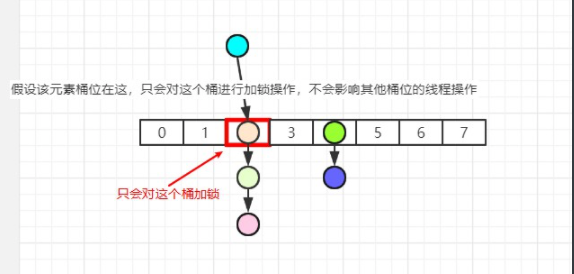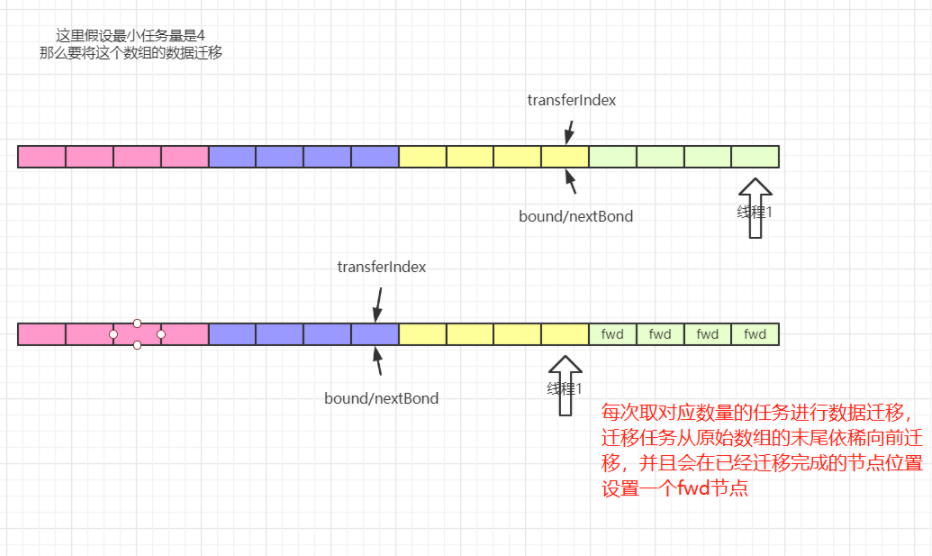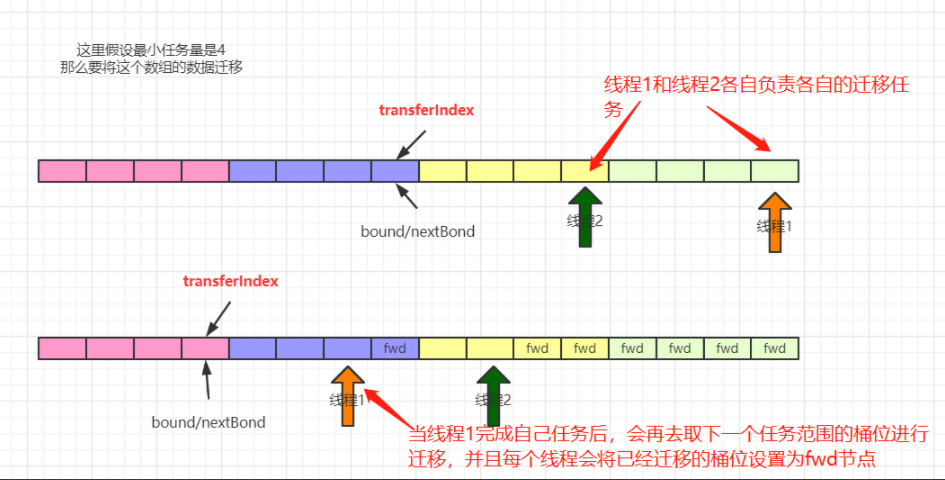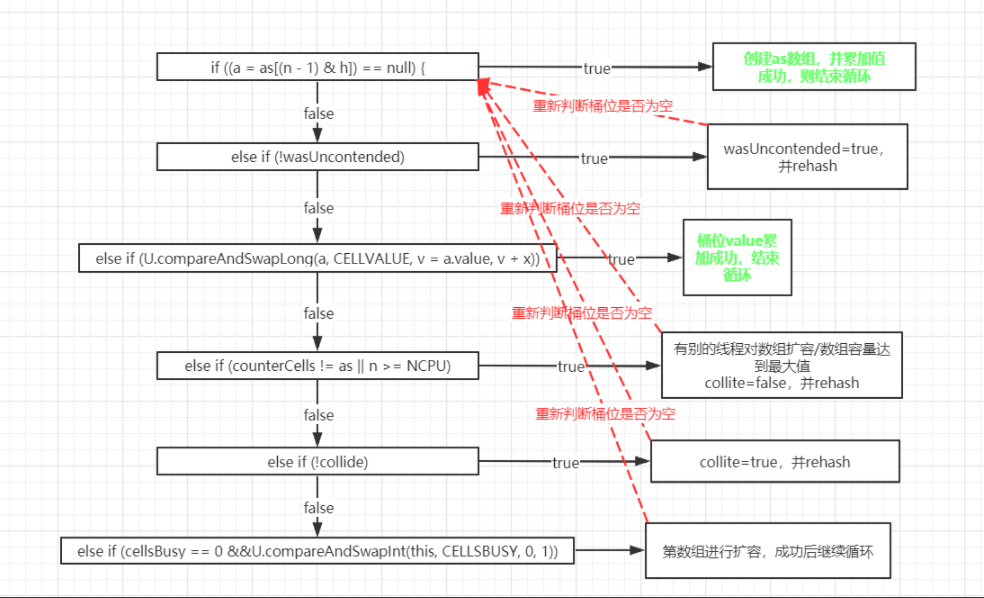# ConcurrentHashMap源码分析(二)
# 一、jdk1.8容器初始化
# 1、源码分析
在jdk8的ConcurrentHashMap中一共有5个构造方法,这四个构造方法中都没有对内部的数组做初始化, 只是对一些变量的初始值做了处理
jdk8的ConcurrentHashMap的数组初始化是在第一次添加元素时完成
//没有维护任何变量的操作,如果调用该方法,数组长度默认是16
public ConcurrentHashMap() {
}
//传递进来一个初始容量,ConcurrentHashMap会基于这个值计算一个比这个值大的2的幂次方数作为初始容量
public ConcurrentHashMap(int initialCapacity) {
if (initialCapacity < 0)
throw new IllegalArgumentException();
int cap = ((initialCapacity >= (MAXIMUM_CAPACITY >>> 1)) ?
MAXIMUM_CAPACITY :
tableSizeFor(initialCapacity + (initialCapacity >>> 1) + 1));
this.sizeCtl = cap;
}
注意,调用这个方法,得到的初始容量和我们之前讲的HashMap以及jdk7的ConcurrentHashMap不同,即使你传递的是一个2的幂次方数,该方法计算出来的初始容量依然是比这个值大的2的幂次方数
//调用四个参数的构造
public ConcurrentHashMap(int initialCapacity, float loadFactor) {
this(initialCapacity, loadFactor, 1);
}
//计算一个大于或者等于给定的容量值,该值是2的幂次方数作为初始容量
public ConcurrentHashMap(int initialCapacity,
float loadFactor, int concurrencyLevel) {
if (!(loadFactor > 0.0f) || initialCapacity < 0 || concurrencyLevel <= 0)
throw new IllegalArgumentException();
if (initialCapacity < concurrencyLevel) // Use at least as many bins
initialCapacity = concurrencyLevel; // as estimated threads
long size = (long)(1.0 + (long)initialCapacity / loadFactor);
int cap = (size >= (long)MAXIMUM_CAPACITY) ?
MAXIMUM_CAPACITY : tableSizeFor((int)size);
this.sizeCtl = cap;
}
//基于一个Map集合,构建一个ConcurrentHashMap
//初始容量为16
public ConcurrentHashMap(Map<? extends K, ? extends V> m) {
this.sizeCtl = DEFAULT_CAPACITY;
putAll(m);
}
# 2、sizeCtl含义解释
注意:以上这些构造方法中,都涉及到一个变量
sizeCtl,这个变量是一个非常重要的变量,而且具有非常丰富的含义,它的值不同,对应的含义也不一样,这里我们先对这个变量不同的值的含义做一下说明,后续源码分析过程中,进一步解释
sizeCtl为0,代表数组未初始化, 且数组的初始容量为16
sizeCtl为正数,如果数组未初始化,那么其记录的是数组的初始容量,如果数组已经初始化,那么其记录的是数组的扩容阈值
sizeCtl为-1,表示数组正在进行初始化
sizeCtl小于0,并且不是-1,表示数组正在扩容, -(1+n),表示此时有n个线程正在共同完成数组的扩容操作
# 二、jdk1.8添加安全
# 1、源码分析
# 1.1、添加元素put/putVal方法
public V put(K key, V value) {
return putVal(key, value, false);
}
final V putVal(K key, V value, boolean onlyIfAbsent) {
//如果有空值或者空键,直接抛异常
if (key == null || value == null) throw new NullPointerException();
//基于key计算hash值,并进行一定的扰动
int hash = spread(key.hashCode());
//记录某个桶上元素的个数,如果超过8个,会转成红黑树
int binCount = 0;
for (Node<K,V>[] tab = table;;) {
Node<K,V> f; int n, i, fh;
//如果数组还未初始化,先对数组进行初始化
if (tab == null || (n = tab.length) == 0)
tab = initTable();
//如果hash计算得到的桶位置没有元素,利用cas将元素添加
else if ((f = tabAt(tab, i = (n - 1) & hash)) == null) {
//cas+自旋(和外侧的for构成自旋循环),保证元素添加安全
if (casTabAt(tab, i, null,
new Node<K,V>(hash, key, value, null)))
break; // no lock when adding to empty bin
}
//如果hash计算得到的桶位置元素的hash值为MOVED,证明正在扩容,那么协助扩容
else if ((fh = f.hash) == MOVED)
tab = helpTransfer(tab, f);
else {
//hash计算的桶位置元素不为空,且当前没有处于扩容操作,进行元素添加
V oldVal = null;
//对当前桶进行加锁,保证线程安全,执行元素添加操作
synchronized (f) {
if (tabAt(tab, i) == f) {
//普通链表节点
if (fh >= 0) {
binCount = 1;
for (Node<K,V> e = f;; ++binCount) {
K ek;
if (e.hash == hash &&
((ek = e.key) == key ||
(ek != null && key.equals(ek)))) {
oldVal = e.val;
if (!onlyIfAbsent)
e.val = value;
break;
}
Node<K,V> pred = e;
if ((e = e.next) == null) {
pred.next = new Node<K,V>(hash, key,
value, null);
break;
}
}
}
//树节点,将元素添加到红黑树中
else if (f instanceof TreeBin) {
Node<K,V> p;
binCount = 2;
if ((p = ((TreeBin<K,V>)f).putTreeVal(hash, key,
value)) != null) {
oldVal = p.val;
if (!onlyIfAbsent)
p.val = value;
}
}
}
}
if (binCount != 0) {
//链表长度大于/等于8,将链表转成红黑树
if (binCount >= TREEIFY_THRESHOLD)
treeifyBin(tab, i);
//如果是重复键,直接将旧值返回
if (oldVal != null)
return oldVal;
break;
}
}
}
//添加的是新元素,维护集合长度,并判断是否要进行扩容操作
addCount(1L, binCount);
return null;
}
通过以上源码,我们可以看到,当需要添加元素时,会针对当前元素所对应的桶位进行加锁操作,这样一方面保证元素添加时,多线程的安全,同时对某个桶位加锁不会影响其他桶位的操作,进一步提升多线程的并发效率
# 1.2、数组初始化,initTable方法
private final Node<K,V>[] initTable() {
Node<K,V>[] tab; int sc;
//cas+自旋,保证线程安全,对数组进行初始化操作
while ((tab = table) == null || tab.length == 0) {
//如果sizeCtl的值(-1)小于0,说明此时正在初始化, 让出cpu
if ((sc = sizeCtl) < 0)
Thread.yield(); // lost initialization race; just spin
//cas修改sizeCtl的值为-1,修改成功,进行数组初始化,失败,继续自旋
else if (U.compareAndSwapInt(this, SIZECTL, sc, -1)) {
try {
if ((tab = table) == null || tab.length == 0) {
//sizeCtl为0,取默认长度16,否则去sizeCtl的值
int n = (sc > 0) ? sc : DEFAULT_CAPACITY;
@SuppressWarnings("unchecked")
//基于初始长度,构建数组对象
Node<K,V>[] nt = (Node<K,V>[])new Node<?,?>[n];
table = tab = nt;
//计算扩容阈值,并赋值给sc
sc = n - (n >>> 2);
}
} finally {
//将扩容阈值,赋值给sizeCtl
sizeCtl = sc;
}
break;
}
}
return tab;
}
# 2、图解
# 2.1、put加锁图解

# 三、jdk1.8扩容安全
# 1、源码分析
private final void transfer(Node<K,V>[] tab, Node<K,V>[] nextTab) {
int n = tab.length, stride;
//如果是多cpu,那么每个线程划分任务,最小任务量是16个桶位的迁移
if ((stride = (NCPU > 1) ? (n >>> 3) / NCPU : n) < MIN_TRANSFER_STRIDE)
stride = MIN_TRANSFER_STRIDE; // subdivide range
//如果是扩容线程,此时新数组为null
if (nextTab == null) { // initiating
try {
@SuppressWarnings("unchecked")
//两倍扩容创建新数组
Node<K,V>[] nt = (Node<K,V>[])new Node<?,?>[n << 1];
nextTab = nt;
} catch (Throwable ex) { // try to cope with OOME
sizeCtl = Integer.MAX_VALUE;
return;
}
nextTable = nextTab;
//记录线程开始迁移的桶位,从后往前迁移
transferIndex = n;
}
//记录新数组的末尾
int nextn = nextTab.length;
//已经迁移的桶位,会用这个节点占位(这个节点的hash值为-1--MOVED)
ForwardingNode<K,V> fwd = new ForwardingNode<K,V>(nextTab);
boolean advance = true;
boolean finishing = false; // to ensure sweep before committing nextTab
for (int i = 0, bound = 0;;) {
Node<K,V> f; int fh;
while (advance) {
int nextIndex, nextBound;
//i记录当前正在迁移桶位的索引值
//bound记录下一次任务迁移的开始桶位
//--i >= bound 成立表示当前线程分配的迁移任务还没有完成
if (--i >= bound || finishing)
advance = false;
//没有元素需要迁移 -- 后续会去将扩容线程数减1,并判断扩容是否完成
else if ((nextIndex = transferIndex) <= 0) {
i = -1;
advance = false;
}
//计算下一次任务迁移的开始桶位,并将这个值赋值给transferIndex
else if (U.compareAndSwapInt
(this, TRANSFERINDEX, nextIndex,
nextBound = (nextIndex > stride ?
nextIndex - stride : 0))) {
bound = nextBound;
i = nextIndex - 1;
advance = false;
}
}
//如果没有更多的需要迁移的桶位,就进入该if
if (i < 0 || i >= n || i + n >= nextn) {
int sc;
//扩容结束后,保存新数组,并重新计算扩容阈值,赋值给sizeCtl
if (finishing) {
nextTable = null;
table = nextTab;
sizeCtl = (n << 1) - (n >>> 1);
return;
}
//扩容任务线程数减1
if (U.compareAndSwapInt(this, SIZECTL, sc = sizeCtl, sc - 1)) {
//判断当前所有扩容任务线程是否都执行完成
if ((sc - 2) != resizeStamp(n) << RESIZE_STAMP_SHIFT)
return;
//所有扩容线程都执行完,标识结束
finishing = advance = true;
i = n; // recheck before commit
}
}
//当前迁移的桶位没有元素,直接在该位置添加一个fwd节点
else if ((f = tabAt(tab, i)) == null)
advance = casTabAt(tab, i, null, fwd);
//当前节点已经被迁移
else if ((fh = f.hash) == MOVED)
advance = true; // already processed
else {
//当前节点需要迁移,加锁迁移,保证多线程安全
//此处迁移逻辑和jdk7的ConcurrentHashMap相同,不再赘述
synchronized (f) {
if (tabAt(tab, i) == f) {
Node<K,V> ln, hn;
if (fh >= 0) {
int runBit = fh & n;
Node<K,V> lastRun = f;
for (Node<K,V> p = f.next; p != null; p = p.next) {
int b = p.hash & n;
if (b != runBit) {
runBit = b;
lastRun = p;
}
}
if (runBit == 0) {
ln = lastRun;
hn = null;
}
else {
hn = lastRun;
ln = null;
}
for (Node<K,V> p = f; p != lastRun; p = p.next) {
int ph = p.hash; K pk = p.key; V pv = p.val;
if ((ph & n) == 0)
ln = new Node<K,V>(ph, pk, pv, ln);
else
hn = new Node<K,V>(ph, pk, pv, hn);
}
setTabAt(nextTab, i, ln);
setTabAt(nextTab, i + n, hn);
setTabAt(tab, i, fwd);
advance = true;
}
else if (f instanceof TreeBin) {
TreeBin<K,V> t = (TreeBin<K,V>)f;
TreeNode<K,V> lo = null, loTail = null;
TreeNode<K,V> hi = null, hiTail = null;
int lc = 0, hc = 0;
for (Node<K,V> e = t.first; e != null; e = e.next) {
int h = e.hash;
TreeNode<K,V> p = new TreeNode<K,V>
(h, e.key, e.val, null, null);
if ((h & n) == 0) {
if ((p.prev = loTail) == null)
lo = p;
else
loTail.next = p;
loTail = p;
++lc;
}
else {
if ((p.prev = hiTail) == null)
hi = p;
else
hiTail.next = p;
hiTail = p;
++hc;
}
}
ln = (lc <= UNTREEIFY_THRESHOLD) ? untreeify(lo) :
(hc != 0) ? new TreeBin<K,V>(lo) : t;
hn = (hc <= UNTREEIFY_THRESHOLD) ? untreeify(hi) :
(lc != 0) ? new TreeBin<K,V>(hi) : t;
setTabAt(nextTab, i, ln);
setTabAt(nextTab, i + n, hn);
setTabAt(tab, i, fwd);
advance = true;
}
}
}
}
}
}
# 2、图解

# 四、jdk1.8多线程扩容效率改进
多线程协助扩容的操作会在两个地方被触发:
① 当添加元素时,发现添加的元素对用的桶位为fwd节点,就会先去协助扩容,然后再添加元素
② 当添加完元素后,判断当前元素个数达到了扩容阈值,此时发现sizeCtl的值小于0,并且新数组不为空,这个时候,会去协助扩容
# 1、源码分析
# 1.1、元素未添加,先协助扩容,扩容完后再添加元素
final V putVal(K key, V value, boolean onlyIfAbsent) {
if (key == null || value == null) throw new NullPointerException();
int hash = spread(key.hashCode());
int binCount = 0;
for (Node<K,V>[] tab = table;;) {
Node<K,V> f; int n, i, fh;
if (tab == null || (n = tab.length) == 0)
tab = initTable();
else if ((f = tabAt(tab, i = (n - 1) & hash)) == null) {
if (casTabAt(tab, i, null,
new Node<K,V>(hash, key, value, null)))
break; // no lock when adding to empty bin
}
//发现此处为fwd节点,协助扩容,扩容结束后,再循环回来添加元素
else if ((fh = f.hash) == MOVED)
tab = helpTransfer(tab, f);
//省略代码
final Node<K,V>[] helpTransfer(Node<K,V>[] tab, Node<K,V> f) {
Node<K,V>[] nextTab; int sc;
if (tab != null && (f instanceof ForwardingNode) &&
(nextTab = ((ForwardingNode<K,V>)f).nextTable) != null) {
int rs = resizeStamp(tab.length);
while (nextTab == nextTable && table == tab &&
(sc = sizeCtl) < 0) {
if ((sc >>> RESIZE_STAMP_SHIFT) != rs || sc == rs + 1 ||
sc == rs + MAX_RESIZERS || transferIndex <= 0)
break;
if (U.compareAndSwapInt(this, SIZECTL, sc, sc + 1)) {
//扩容,传递一个不是null的nextTab
transfer(tab, nextTab);
break;
}
}
return nextTab;
}
return table;
}
# 1.2、先添加元素,再协助扩容
private final void addCount(long x, int check) {
//省略代码
if (check >= 0) {
Node<K,V>[] tab, nt; int n, sc;
//元素个数达到扩容阈值
while (s >= (long)(sc = sizeCtl) && (tab = table) != null &&
(n = tab.length) < MAXIMUM_CAPACITY) {
int rs = resizeStamp(n);
//sizeCtl小于0,说明正在执行扩容,那么协助扩容
if (sc < 0) {
if ((sc >>> RESIZE_STAMP_SHIFT) != rs || sc == rs + 1 ||
sc == rs + MAX_RESIZERS || (nt = nextTable) == null ||
transferIndex <= 0)
break;
if (U.compareAndSwapInt(this, SIZECTL, sc, sc + 1))
transfer(tab, nt);
}
else if (U.compareAndSwapInt(this, SIZECTL, sc,
(rs << RESIZE_STAMP_SHIFT) + 2))
transfer(tab, null);
s = sumCount();
}
}
}
注意:扩容的代码都在transfer方法中,这里不再赘述
# 2、图解

# 五、集合长度的累计方式
# 1、源码分析
# 1.1、addCount方法
① CounterCell数组不为空,优先利用数组中的CounterCell记录数量
② 如果数组为空,尝试对baseCount进行累加,失败后,会执行fullAddCount逻辑
③ 如果是添加元素操作,会继续判断是否需要扩容
private final void addCount(long x, int check) {
CounterCell[] as; long b, s;
//当CounterCell数组不为空,则优先利用数组中的CounterCell记录数量
//或者当baseCount的累加操作失败,会利用数组中的CounterCell记录数量
if ((as = counterCells) != null ||
!U.compareAndSwapLong(this, BASECOUNT, b = baseCount, s = b + x)) {
CounterCell a; long v; int m;
//标识是否有多线程竞争
boolean uncontended = true;
//当as数组为空
//或者当as长度为0
//或者当前线程对应的as数组桶位的元素为空
//或者当前线程对应的as数组桶位不为空,但是累加失败
if (as == null || (m = as.length - 1) < 0 ||
(a = as[ThreadLocalRandom.getProbe() & m]) == null ||
!(uncontended =
U.compareAndSwapLong(a, CELLVALUE, v = a.value, v + x))) {
//以上任何一种情况成立,都会进入该方法,传入的uncontended是false
fullAddCount(x, uncontended);
return;
}
if (check <= 1)
return;
//计算元素个数
s = sumCount();
}
if (check >= 0) {
Node<K,V>[] tab, nt; int n, sc;
//当元素个数达到扩容阈值
//并且数组不为空
//并且数组长度小于限定的最大值
//满足以上所有条件,执行扩容
while (s >= (long)(sc = sizeCtl) && (tab = table) != null &&
(n = tab.length) < MAXIMUM_CAPACITY) {
//这个是一个很大的正数
int rs = resizeStamp(n);
//sc小于0,说明有线程正在扩容,那么会协助扩容
if (sc < 0) {
//扩容结束或者扩容线程数达到最大值或者扩容后的数组为null或者没有更多的桶位需要转移,结束操作
if ((sc >>> RESIZE_STAMP_SHIFT) != rs || sc == rs + 1 ||
sc == rs + MAX_RESIZERS || (nt = nextTable) == null ||
transferIndex <= 0)
break;
//扩容线程加1,成功后,进行协助扩容操作
if (U.compareAndSwapInt(this, SIZECTL, sc, sc + 1))
//协助扩容,newTable不为null
transfer(tab, nt);
}
//没有其他线程在进行扩容,达到扩容阈值后,给sizeCtl赋了一个很大的负数
//1+1=2 --》 代表此时有一个线程在扩容
//rs << RESIZE_STAMP_SHIFT)是一个很大的负数
else if (U.compareAndSwapInt(this, SIZECTL, sc,
(rs << RESIZE_STAMP_SHIFT) + 2))
//扩容,newTable为null
transfer(tab, null);
s = sumCount();
}
}
}
# 1.2、fullAddCount方法
① 当CounterCell数组不为空,优先对CounterCell数组中的CounterCell的value累加
② 当CounterCell数组为空,会去创建CounterCell数组,默认长度为2,并对数组中的CounterCell的value累加
③ 当数组为空,并且此时有别的线程正在创建数组,那么尝试对baseCount做累加,成功即返回,否则自旋
private final void fullAddCount(long x, boolean wasUncontended) {
int h;
//获取当前线程的hash值
if ((h = ThreadLocalRandom.getProbe()) == 0) {
ThreadLocalRandom.localInit(); // force initialization
h = ThreadLocalRandom.getProbe();
wasUncontended = true;
}
//标识是否有冲突,如果最后一个桶不是null,那么为true
boolean collide = false; // True if last slot nonempty
for (;;) {
CounterCell[] as; CounterCell a; int n; long v;
//数组不为空,优先对数组中CouterCell的value累加
if ((as = counterCells) != null && (n = as.length) > 0) {
//线程对应的桶位为null
if ((a = as[(n - 1) & h]) == null) {
if (cellsBusy == 0) { // Try to attach new Cell
//创建CounterCell对象
CounterCell r = new CounterCell(x); // Optimistic create
//利用CAS修改cellBusy状态为1,成功则将刚才创建的CounterCell对象放入数组中
if (cellsBusy == 0 &&
U.compareAndSwapInt(this, CELLSBUSY, 0, 1)) {
boolean created = false;
try { // Recheck under lock
CounterCell[] rs; int m, j;
//桶位为空, 将CounterCell对象放入数组
if ((rs = counterCells) != null &&
(m = rs.length) > 0 &&
rs[j = (m - 1) & h] == null) {
rs[j] = r;
//表示放入成功
created = true;
}
} finally {
cellsBusy = 0;
}
if (created) //成功退出循环
break;
//桶位已经被别的线程放置了已给CounterCell对象,继续循环
continue; // Slot is now non-empty
}
}
collide = false;
}
//桶位不为空,重新计算线程hash值,然后继续循环
else if (!wasUncontended) // CAS already known to fail
wasUncontended = true; // Continue after rehash
//重新计算了hash值后,对应的桶位依然不为空,对value累加
//成功则结束循环
//失败则继续下面判断
else if (U.compareAndSwapLong(a, CELLVALUE, v = a.value, v + x))
break;
//数组被别的线程改变了,或者数组长度超过了可用cpu大小,重新计算线程hash值,否则继续下一个判断
else if (counterCells != as || n >= NCPU)
collide = false; // At max size or stale
//当没有冲突,修改为有冲突,并重新计算线程hash,继续循环
else if (!collide)
collide = true;
//如果CounterCell的数组长度没有超过cpu核数,对数组进行两倍扩容
//并继续循环
else if (cellsBusy == 0 &&
U.compareAndSwapInt(this, CELLSBUSY, 0, 1)) {
try {
if (counterCells == as) {// Expand table unless stale
CounterCell[] rs = new CounterCell[n << 1];
for (int i = 0; i < n; ++i)
rs[i] = as[i];
counterCells = rs;
}
} finally {
cellsBusy = 0;
}
collide = false;
continue; // Retry with expanded table
}
h = ThreadLocalRandom.advanceProbe(h);
}
//CounterCell数组为空,并且没有线程在创建数组,修改标记,并创建数组
else if (cellsBusy == 0 && counterCells == as &&
U.compareAndSwapInt(this, CELLSBUSY, 0, 1)) {
boolean init = false;
try { // Initialize table
if (counterCells == as) {
CounterCell[] rs = new CounterCell[2];
rs[h & 1] = new CounterCell(x);
counterCells = rs;
init = true;
}
} finally {
cellsBusy = 0;
}
if (init)
break;
}
//数组为空,并且有别的线程在创建数组,那么尝试对baseCount做累加,成功就退出循环,失败就继续循环
else if (U.compareAndSwapLong(this, BASECOUNT, v = baseCount, v + x))
break; // Fall back on using base
}
}
# 2、图解
fullAddCount方法中,当as数组不为空的逻辑图解

# 六、jdk1.8集合长度获取
# 1、源码分析
# 1.1、size方法
public int size() {
long n = sumCount();
return ((n < 0L) ? 0 :
(n > (long)Integer.MAX_VALUE) ? Integer.MAX_VALUE :
(int)n);
}
# 1.2、sumCount方法
final long sumCount() {
CounterCell[] as = counterCells; CounterCell a;
//获取baseCount的值
long sum = baseCount;
if (as != null) {
//遍历CounterCell数组,累加每一个CounterCell的value值
for (int i = 0; i < as.length; ++i) {
if ((a = as[i]) != null)
sum += a.value;
}
}
return sum;
}
注意:这个方法并不是线程安全的